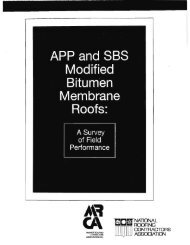The Relationship Still Rules! - Midwest Roofing Contractors ...
The Relationship Still Rules! - Midwest Roofing Contractors ...
The Relationship Still Rules! - Midwest Roofing Contractors ...
You also want an ePaper? Increase the reach of your titles
YUMPU automatically turns print PDFs into web optimized ePapers that Google loves.
OSHA standard for fixed ladders. You are not going to be able to defend<br />
yourself by saying, “Well, I just used the ladder that my customer had<br />
available,” “It’s not my ladder,” or “I didn’t install it, my employees are<br />
just using it.” <strong>The</strong>se statements will get you absolutely nowhere in an<br />
OSHA compliance inspection. Instead, ensure that<br />
• the distance from the first rung to the ground is within the distance<br />
permitted by the standard<br />
• the rungs of the fixed ladder are at a minimum distance from the<br />
wall or the side of the building against which the ladder is attached<br />
and that they are within the prescribed tolerances for the distance<br />
between rungs<br />
• there are handholds or another means of safely getting off the ladder<br />
when the employee reaches the roof or level to which he/she is<br />
ascending.<br />
As in Subpart M, there are many sections of the ladder safety standard<br />
that apply to roofing contractors that can be easily violated—too<br />
many to cover in this short article.<br />
As a roofing contractor, you need to be aware that OSHA is taking a<br />
very hard line in enforcing fall protection and ladder safety standards.<br />
I know your ultimate concern is the safety of your employees, but<br />
bear in mind that in the past year, OSHA citations on fall protection<br />
are frequently not getting reductions in fines due to contractors’ size,<br />
history, or good faith when they are first issued. In many cases, serious<br />
violations are being issued at $7,000 per violation with no reduction.<br />
OSHA is taking a look at each employer they inspect. You certainly<br />
do not want to be cited for a willful violation. In many cases it is not the<br />
monetary fine that is a problem but the impact that serious or willful<br />
violations might have on your ability to bid work in the future. As<br />
recently as 2 or 3 years ago, many contractors looked at OSHA and safety<br />
as a necessary evil to getting the job done. This is no longer the case.<br />
Today, and in the future, safety must be treated on the same level as<br />
any technical aspect of your business if you want to remain successful<br />
and stay in business.<br />
Be sure to attend the 2011 MRCA 62nd Annual Convention in Rosemont,<br />
IL, on October 26–28, and all of the sessions devoted to providing<br />
a safe workplace for your employees.<br />
Gary Auman is a director with Dunlevey, Mahan, & Furry in<br />
Dayton, OH, and is general counsel for MRCA. He can be reached at<br />
GWA@dmfdayton.com or call 1.888.MRCA.LAW.



